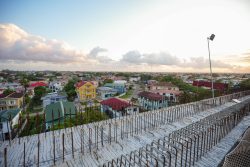The Self-Propelled Semi-Submersible (SPSS) vessel found in a secluded area in Region One, two years ago had the capacity to transport six tonnes of cocaine, Head of the Customs Anti-Narcotic Unit (CANU) James Singh said last Friday while revealing that persons were charged and jailed in another country for their links to the craft.
The vessel is currently in the US where experts are conducting a forensic analysis, the results of which would educate law enforcement authorities on the new methods being used by traffickers to transport drugs. Subsequent to the August 2014 discovery, it was concluded that the vessel was built to transport drugs.
Responding to questions from Stabroek News shortly after the 2016-2020 National Drug Strategy Master Plan was unveiled, Singh said that in addition to its capacity, the vessel was also determined to have a speed of about 12 to 15 knots.
He said that the vessel was donated to the Americans so that they could do a better examination of it with the hope that they would be able to determine its drug-carrying capacity and its range, “because we couldn’t do it here.”

According to James, persons who were involved with the craft were jailed in another country. Asked later for some clarifications since nothing could be found about persons being charged, Singh told Stabroek News that there were two separate aspects of the case.
“The… submarine involved people outside of Guyana and those people, some of them have been charged, successfully prosecuted and imprisoned…. All we did here was send it to the US to say look …check to see if it is a new design, how fast it could go, how far it could go. So that is more part of the investigation aspect. It was not to charge anyone,” he explained.
He reiterated that Guyana’s task was to find out more about the vessel.
CANU had announced the discovery after an operation was conducted by its agents along with the GDF Special Forces, Coast Guard and Air Corps along the Waini River, in the North West District.
CANU said the blue vessel, later identified as a SPSS, was discovered about two miles in during a search of one of the creeks branching off from the Waini. Also found was a camp consisting of three structures for accommodation, a workshop and power generation.
According to CANU, the accommodation had the capacity to sleep approximately 12 persons and it included a kitchen area.
The workshop consisted of pulleys, power tools, paint, and fibre glass materials. “Based on the items present, it is evident that this area was used to build the SPSS found in the creek,” it said in the statement.
CANU added that the craft, upon closer inspection, was already fitted with a diesel engine and steering wheel, navigation and other machinery to deem it serviceable. There was, however, no contraband on board.
Based on the photographs provided by CANU, the vessel was almost completely painted.
“These semi-submersible vessels are built for one reason and one reason only and that is to transport drugs, mainly cocaine. This vessel was more than likely going to Europe or Africa, not the US… the camp itself has been there for at least five months based on the materials found,” Singh had told the media.




